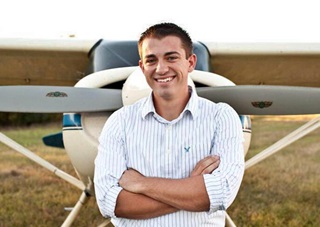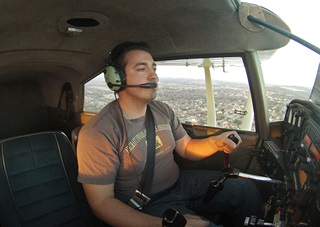
When Calbraith “Cal” Rodgers began his 1911 cross-country flight in the Vin Fiz, a Wright EX single-seat biplane made of wood, cloth, and wire, airports were few, qualified repair stations were nonexistent, and weather reports were sketchy at best.
More than 100 years later, Middle Tennessee State University A&P honor student Collin McDonald plans to re-create the historic flight in his family’s Maule MX7-160. Now, airports dot the country, repair stations are plentiful, and precise weather reports are delivered to cockpits via satellite.
Rodgers, who took flying lessons from the Wright brothers in Dayton, Ohio, set out to capture a $50,000 prize offered by newspaper baron William Randolph Hearst. The money would be awarded to the first aviator to fly coast to coast in 30 days or less. Rodgers secured funding for the flight from Armour & Co., which wanted to promote its new grape-flavored Vin-Fiz soft drink. Rodgers crashed more than a dozen times and survived two engine explosions while en route. By the time he landed in California, only two original parts were left on the airplane: a wing strut and part of the rudder. Rodgers still did not win the prize, but he demonstrated that aircraft could be used for more than airshow routines. The Smithsonian National Air and Space Museum considers Rodgers as one of its pioneers of flight.

McDonald, 21, has finished the flight planning for the trip, which will serve as his senior thesis project. He plans to fly from Long Island, New York, to Long Beach, California, at the end of May, and hopes to receive enough scholarships to cover the cost.
McDonald wrote in his thesis proposal that Rodgers’ flight was a landmark in aviation history because it helped to demonstrate that aircraft could be used for travel. Flight, however, was still in its infancy and very dangerous.
“Rodgers was at the Chicago air meet and had an engine failure, so even he experienced an emergency situation right there,” said McDonald. “The story goes that a magneto failed and he had an emergency dead-stick landing on the airfield. Before the Chicago event, Hearst had already made the $50,000 offer for the first person to fly across the United States. Rodgers was at the [air meet] dinner and Armour offered a sponsorship to Cal if he was interested in going. It ended up being the critical factor,” McDonald said. “The name Vin-Fiz was a new soda, and Cal decided to paint it on the underside of the plane,” he said.
“The Vin Fiz flight changed the perspective of aviation in America. At that time, aircraft were used primarily for demonstration and show-type stuff and not for travel. These airshows resulted in a lot of crashes. As an example, look at the Chicago air meet of 1911 which had become the biggest airshow of its time," he explained. The airshow had fatalities and "incidents where individuals had landings hard enough to break something. One aircraft veered off into the Great Lakes and its pilot ended up drowning during the cross-country demonstration.”
McDonald, who wants to work overseas as a faith-based pilot and will soon graduate with his A&P certificate, said the Vin Fiz flight re-creation will help him build time toward the 500 hours many missionary aviation organizations require as their minimum.
Even with modern technology, McDonald has still faced challenges while planning the trip. “Every evening I spend about an hour planning Vin Fiz. Honestly, scheduling where to land is the hardest thing because Cal just landed in any open field he could find. It was 1911 and there weren’t that many fields designed as airports. In fact, along his route there were none. A lot of the time landings resulted in damage to his aircraft and even to himself. His mechanics were on a train car painted ‘The Vin Fiz Special,’ and they followed the trip along the ground. The route meandered from New York to Chicago, then south to Dallas, then west to El Paso, Texas, up to Phoenix, and then out to Los Angeles.”
The journey will cost about $10,000, McDonald said, adding that he has applied for several aviation scholarships to help cover the cost. He’s received $1,000 through the Tennessee Aviation Association’s John Baugh Aviation Scholarship and raised more than $1,000. He said he was hopeful another scholarship would come through and that “I still need to raise some more funds for the flight to pay for the materials that I will need.” If he does not receive enough in scholarships and donations, McDonald said he would use money he has saved from mowing lawns.

McDonald said the 1995 Maule is up for the 4,000-mile challenge, and he would like avoid an engine failure in Chicago like Rodgers experienced. But, he is pragmatic about the flight. “More than likely I’m going to have a mechanical issue somewhere along the way and I’ve been trained to fix that. The final project will be a comparison of the original flight to mine, looking at the different challenges that we both faced.”
The college senior plans to stop by the Beaufort, North Carolina, AOPA Regional Fly-In on May 21 before departing on the re-creation flight and hopes to inspire the next generation of pilots to follow in his aviation footsteps.
“The more I got into it, the more I wanted to help general aviation,” McDonald said. “I want GA to appear feasible and practical, and I hope more young people feel they can get involved in aviation. We need a new generation of individuals that love aviation, and that’s another purpose of this project.”



